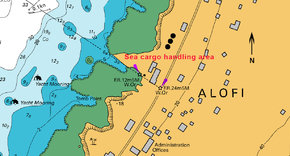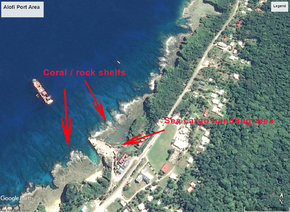Working on using Niue as a NZDF Pac Is base I have done a bit of quick research and leaving out French, Australian and US territories the following distances from Niue in nautical miles:
Niue to Distance (nm)
Cook Islands 587
Fiji 666
Kiribati 1436
Marshall Islands 1564
Nauru 1748
Ohakea, NZ 1468
Samoa 351
Solomon Islands 1842
Tokelau 578
Tonga 316
Tuvalu 946
Vanuatu 1244
Wallis and Fortuna 546
These distances were calculated using Google Earth. Given that the
King Air 350i max range is 1806 nm then the Solomon Islands would require an intermediate refuelling stop and possibly the Marshall Islands and Ohakea depending upon winds and other weather conditions. At 2335 m, the runway at Niue is about 300 m longer than Whenuapai and approx 100 m shorter than Ohakea.
The current ship handling facilities at Alofi would have to be vastly improved and sufficient ship berthing facilities if a suitable wharf and breakwater is built. The predominant wave climate appears to be from the east, so Alofi being on the western side of the island is in the island's lee. The predominant wind direction appears to be from the north west to north east quadrant. However the wind and wave factors can only be determined properly by a significant study.
View attachment 46161
From the nautical chart it appears that the the water depth there allows room for decent berthing of ships up to a draught of 6+ metres if it is extended out to the 9 m isobath (line of equal depth). The 5 m isobath is quite close in and the 10 m isobath is not that far out. In fact the 5 m isobath runs quite close in to the shore by what appears to be rock or coral shelves, as seen in the image below.
View attachment 46162
I am not an engineer so I cannot comment upon the feasibility on constructing a wharf and breakwater here, but if it was to go ahead as a NZ soft power project it would significantly increase NZ's presence and mana within the South Pacific. If the facilities were constructed to withstand significant cyclone damage then they could be used to predeploy emergency aid for the region.
Another option would be to use Tonga as the hub instead of Niue, but Tonga has had some unrest over recent years and could be a riskier option in that aspect. It is has a significant PRC development presence, hence it may be in NZG's interest to dig deep and go all out to replace the PRC in Tonga, buying Tonga's debt then building a NZDF Pac Is hub there. The money such a development would bring into Tonga would be more than welcomed. Mind you the same can be said for Niue or an other South Pacific nation.


